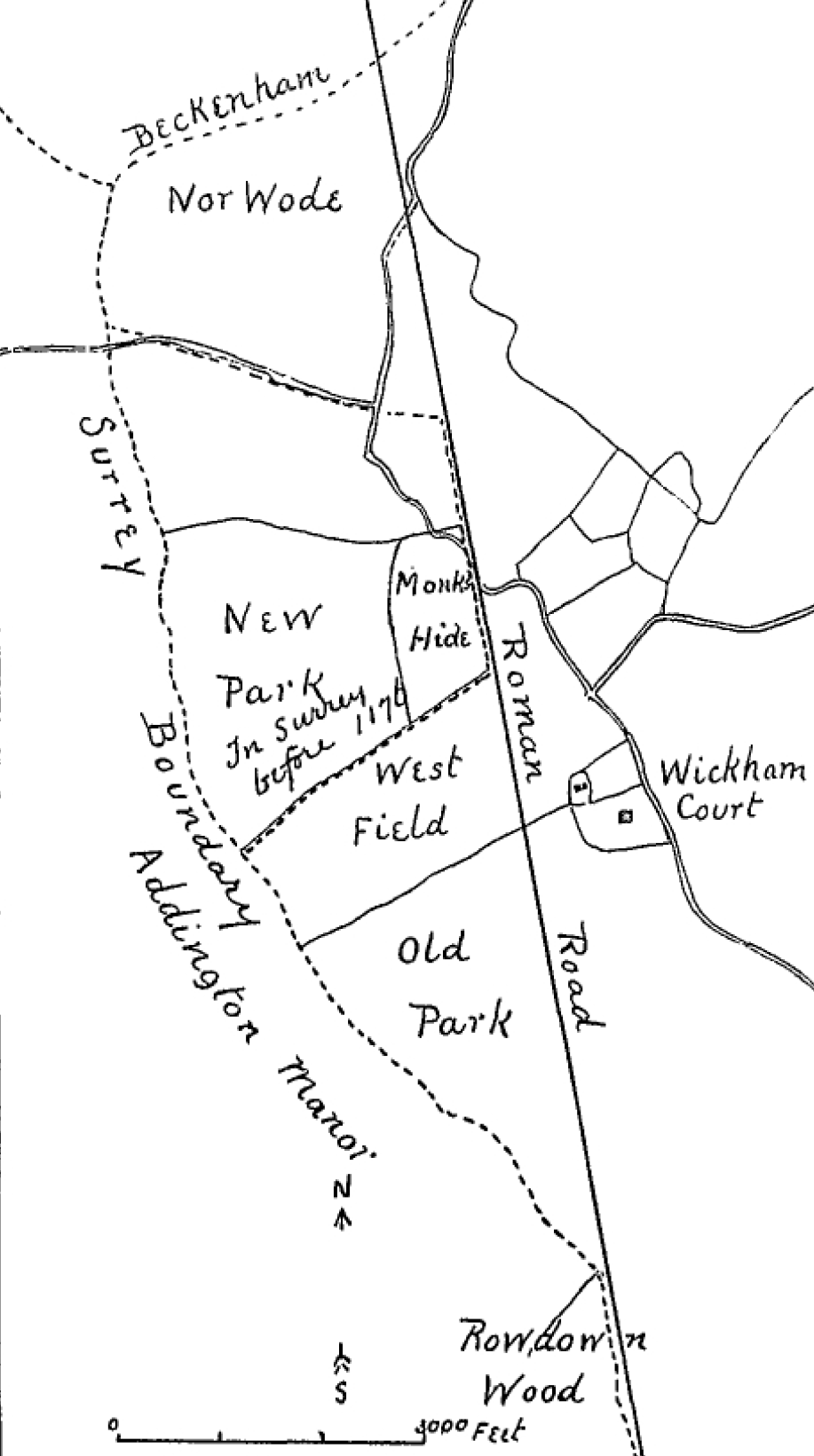
An Early Alteration of the Boundary between Kent and Surrey
Contributions to the next volume are welcome. See the guidance for contributors and contact Editor Jason Mazzocchi. Also see the guidance for peer review.
Search page
Search within this page here, search the collection page or search the website.
Notes on Wallpapers
Eynsford Church in the Valley of the Darent
( 152 ) AN EARLY ALTERATION OP THE BOUNDARY BETWEEN KENT AND SURREY BY BERNARD E. DAVIS ON the Pipe RoU of the year 1176 it is recorded that Hugh Pincerna owed 300 marks for a disseisin made with the monks of Rochester, and for another disseisin made with Bartholomew de Chesny, and for the boundary between Kent and Surrey. In other words he had acquhed land from Bartholemew and had permission to alter the County boundary. The bulk of the fine was paid in Hugh's hfe time, the remainder by his son Adam. To explain where this alteration occurred one must go back to the time of the Domesday Survey. Adam, son of Hubert de Ria, held much land in Kent, and amongst it he had Wicham, Culing and Grey. He also held one hide in Surrey, in WaUington Hundred. Adam died shortly after the Survey, his possessions coming to Eudes, his brother, whose principal seat was at Colchester. Eudes gave Wickham, CuUng and Crey to Ralph, his butler (pincerna, cupbearer, butler), and one may suppose that he also gave him the land in Surrey, at least there is no other recorded owner. About the year 1100, Eudes founded the Monastery of St. John's, Colchester, and Ralph also made bequests. The Cartulary of that house records t h a t: Ralph Pincerna granted haU a hide of land and two men in Wickham. Adam Pincerna confirms the gift of his father Ralph— of haU a hide of land and two men in his Manor of Wickham. Two of the witnesses to bis deed are Sturmus and Roger of Kent. Hugh Pincerna confirms to the monies, the haU hide in Wickham and two men—" which Ralph Pincerna my BOUNDARY BETWEEN KENT AND SURREY. 153 Y Wor WocU A i /A. \. i (' \ ^ c/>\ i""\ ^\ =-\• '\ \A \'\ / X/ H ', \ \ / / <<• y-— -- -r^ /W " ^ / [M°HfcLX^^ i ^ Wv\/ \ ^r^As\k x t\du>w te ^ " £ \ / F^cW JrAjL 77 ^ - /-^ \ \ \f ou U •% \ \ \ - \ \ rJ \ \ * \ \ /I S Wood [\ ». . . •i"'"'^,/ 'A XJ / V\lLckham \Court > . ^ THE KENT-SURREY BOUNDARY AT WEST WICKHAM. 154 AN EARLY ALTERATION OF THE grandfather gave them and Adam Pincerna his son confirmed to them, viz. haU a hide in Wickham that Ues in Surrey and also two men with theh tenements." The witnesses to this deed place its date at about 1169, note also the mention of Surrey. The final reference relates that, Walter Abbot of Colchester grants the haU hide in Wickham to Hugh Pincerna at a rent of 10s., which hah hide Ues in Surrey, and two men which Ralph Pincerna gave to the monks. Hugh was succeeded by his son Adam and he by WiUiam, whose son Hugh, being a minor, Wickham for a time was held by his guardian WiUiam de Stanes. This succession can be foUowed on the Pipe RoUs, and is mentioned in the Assize RoUs', Close RoUs and Book of Fees, leaving no room for doubt that West Wickham in Kent is the Manor referred to. Also one must remember that Bartholemew de Chesny held the Manor of Addington in WaUington Hundred, Surrey. There is therefore, very Uttle room for doubting that the haU hide in Surrey was the land mentioned in 1089 as held by Adam, son of Hubert. But there is no record that any land in Surrey was held by the descendants of Hugh Pincerna after 1176, therefore the change in the county boundary must have brought it into Kent. (From c. 1220 the various records usuaUy refer to members of this famUy as " le Butiler.") The manor records of West Wickham which date from 1310, provide further evidence, Monk's Hide is often mentioned and its position plainly marked, but it does not adjoin the Surrey boundary of to-day, there is another piece of land which must be included in the transfer ; this piece has always been caUed " The New Park," or, in later times, " Spring Park," and it is reasonable to suppose that it was the land sold by Bartholemew de Chesny. One interesting point to notice is that one side of Monk's Hide Ues exactly along the Une of the Roman Road which I have recently surveyed. A glance at the map might lead one to suppose that the county boundary originaUy foUowed the Roman Road from BOUNDARY BETWEEN KENT AND SURREY. 155 Rowdown Wood to Monk's Hide and that the whole of this area was brought into Kent in 1176, but that would mean that the bulk of the demesne lands of Wickham Court, including " The Old Park," were in Surrey. Domesday Survey does not record that, and the name of Old Park in comparison with New Park, impUes that the former was an earUer part of the demesne. Rather, I think, the divergence of the boundary from the Une of Roman Road and round the demesne indicates an occupied site before the boundary was marked out and that is probably going very near to the time of the Roman occupation, and suggests the possible site of a Romano-British holding at Wickham. How the Surrey boundary ran to the North of Monk's Hide can only be surmised. I can only suggest the South side of Wickham Street as a possible Une, as in this way two ancient tenements would be associated with Monk's Hide in Surrey.
